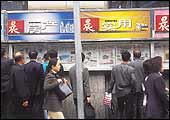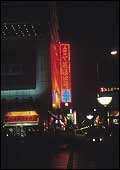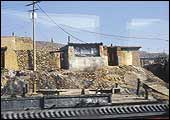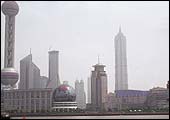|
Taxis are a popular means of getting
around in Shanghai. It isn't that the Shanghainese and the expats-the
Japanese and the Taiwanese are the two largest communities-don't
like the subway, parts of it spiffy and four impressive levels down
into the bowels of the earth. It's just that the subway doesn't
go everywhere like the London Underground does. Then, there's the
rain: short, intense, eccentric bursts of it that necessitate a
dive for the nearest cab. Chances are, then, that if you've been
to Shanghai you've taken a cab, likely one belonging to the Shanghai
Dazhong Taxi Co, the largest in the city. Dazhong is no ordinary
taxi company. It was set up in 1989 under the supervision of then
Deputy Premier Zhu Rongji (now premier), and was amongst China's
first attempts to repurpose employees of its large, cumbersome,
ailing public sector (the term of choice is State-owned Enterprises,
SoEs) that accounts for anything between 40 and 70 per cent of the
country's economy depending on your source of information. Thus,
when Liu Jin Ping, Shanghai's Vice Chairman (the equivalent of a
Minister of State in India) of the Foreign Economic Relations &
Trade Commission and the Foreign Investment Commission, says the
city has been able to "restructure SoEs by laying off close
to 1 million workers and retrain them to work in the tertiary sector
(read: services)", he is referring to initiatives like Dazhong
Taxi, many of whose cab drivers are former steel workers. Today,
adds Liu, SoEs account for 70 per cent of Shanghai's economy (down
from 90 per cent in the 1990s), and the tertiary sector's share
in the economy is up to 60 per cent. Shanghai's experiment with
taxis is germane to the larger problem China, as a whole, faces:
a 10 per cent reduction in the 150 million SoE workforce over the
next eight years (up to 2010) translates into the need to create
1.8 million new jobs a year; exacerbating things are the organic
growth in the population and surplus agricultural labour, which
require the creation of another 2.3 to 2.7 million jobs a year.
Taxi companies and utilities, however, can only do so much, and
China is counting on the emergence of organised retail, and the
imminent divestment of some SoEs to help address the issue.
| |
1990
|
2020
|
| GNP |
Rs 16,59,200 crore
|
Rs 80,52,000 crore
|
| POPULATION |
1.14 billion
|
1.38 billion
|
| PER CAPITA GNP*** |
Rs 14,554
|
Rs 58,347
|
| URBAN POPULATION |
N.A.*
|
50%
|
| EXPORTS |
Rs 3,02,560 crore
|
19,54,200 crore
|
| PER CAPITA INDIVIDUAL CONSUMPTION |
Rs 4,267
|
20,836
|
| PER CAPITA RURAL INCOME |
N.A.******
|
Rs 47,222
|
| PER CAPITAL URBAN INCOME |
N.A.******
|
Rs 1,18,056
|
| CONTRIBUTION OF PRIMARY INDUSTRY IN GNP |
28.4%
|
12.7%
|
| CONTRIBUTION OF SECONDARY INDUSTRY IN GNP |
43.6%
|
51.3%
|
| CONTRIBUTION OF TERTIARY INDUSTRY IN GNP**** |
28%
|
36%
|
| WORKFORCE IN PRIMARY INDUSTRY |
340.49 million
|
287 million
|
| WORKFORCE IN SECONDARY INDUSTRY |
121.58 million
|
179.38 million
|
| WORKFORCE IN TERTIARY INDUSTRY |
105.33 million
|
251.13 million
|
| AVERAGE ANNUAL FOREIGN INVESTMENT |
Rs 10,161.8 million
|
Rs 4,54,170 million
|
* Estimated at 40 per cent in 2000
**: If population growth is limited to 7 per cent
****: Some estimates put the proportion of the tertiary industry
in GNP in 2010 at 45 per cent
*****: Assuming a 12.5 per cent annual growth rate
******: The two income figures factor in a price rice of 5-6
per cent a year; per capita rural income in 2000 was 3,000 Yuan
(Rs 17,708); per capita urban income between 6,000 (Rs 35,416)
and 7,000 Yuan (Rs 41,319)
Source: The Chinese Economy Into The 21st Century: Li Jingwen |
THE FREE MARKET AS A PROPHYLACTIC
 |
| I read the news today, oh boy. And thanks to
the government's monitoring there really wasn't any bad news |
All signs point to an imminent baby boom in china. the economy
rocks; love, and sex, are in the air in the cities; and the great
move outward to larger houses in the suburbs has begun. It won't
happen. What the market provideth, it shall taketh away. Education,
once free, is becoming expensive. Even government schools find innovative
ways to charge tuition fees. Today, the costs of education could
range from 15,000-20,000 yuan (Rs 88,541-1.18 lakh) a year at the
primary school level to around 60,000-80,000 yuan (Rs 3.5-4.7 lakh)
at the university level. That is a significant amount even for the
highest income segment in China's top four cities (average annual
income: 260,000 yuan, or Rs 15.34 lakh). In a context where every
working couple will soon have to support two sets of parents and
surviving grand parents, that means the one-child system will continue.
 |
| Beijing's shopping street wangfujing could put
similar locations in Hong Kong and Malaysia to shame |
CONSUMERISM IN RED CHINA
Sorry, Karl, but china believes consumption is the secret to a
healthy domestic economy. ''Every time there is a threat of a slowdown,
the government declares holidays or increases salaries in SoEs,''
says Rakesh Sharma, the Chief Representative of the State Bank of
India in Shanghai. The Chinese people rise to the bait: domestic
tourism brought in $44 billion (Rs 2,14,961 crore) in revenues last
year and the proportion of privately-owned vehicles among all vehicles
increased from 14.8 per cent in 1990 to 40 per cent in 2000. Sampling
studies actually place both rural and urban incomes in China higher
than statistical estimates. Gallup believes rural (annual) incomes
are around 7,200 yuan (Rs 42,500) today; urban incomes, 16,600 yuan
(Rs 97,986). Still, all isn't well: over 60 million Chinese live
below the poverty line, and by the end of the last decade the top
20 per cent of China's population earned 9.6 times what the bottom
20 per cent did-up from 4.2 times at the beginning of the 1990s.
''That could be the source of a lot of social instability,'' says
Michael Guo, General Manager, Gallup. China hopes a 7 per cent-plus
growth rate (in GDP) will help initiate a trickle-down effect, and
it has also issued a call for businesses to ''Go West'', an attempt
to spur growth in the under-developed Western part of the country.
The effects of the first are yet to make themselves visible, but
the second, given China's track record at responding to centralised
decision-making should work.
FOREIGN INVESTMENT THAT REALLY
ISN'T FOREIGN
 |
| In China's coal-city Datong, miners lead a sustenance
livelihood in shanty towns such as this one |
A vagrant statistic in a shanghai newspaper tells the story: in
the first three months of 2002, Shanghai attracted over $2 billion
(Rs 9,771 crore) in foreign investment. That's almost equal to the
average annual foreign investment in China at the beginning of the
1990s, and just a little lower than the amount India managed to
attract in 2001. Still, by some definitions, the bulk of FDI (Foreign
Direct Investment) into China isn't really foreign. In the last
seven years the US' share in the foreign investment utilised in
China has crossed double figures only once: 11 per cent of $40.4
billion in 1999. The bulk of FDI into China comes from Hong Kong
(still considered 'foreign' and close to 40 per cent of total FDI),
Japan, Taiwan, and Korea. ''The Taiwanese have taken over Kunshun,''
says Sunil Chhugani the chief representative of Jaykara (HK Limited),
referring to the huge investments by that country into an area in
the Shanghai-Suzhou hi-tech corridor. Chhugani himself has moved
from Taiwan to Shanghai, a natural progression from a recessionary
economy to a booming one.
 |
| PUDONG: A showcase of Sanghai's superiority |
THE DREAM ACROSS THE RIVER
The Shanghainese are a proud people. They don't like their city
being compared with Hong Kong: after all, they argue, Shangai's
economy isn't just built around financial services and real estate,
but also around 'real' businesses like automobiles, petrochemicals,
and pharmaceuticals. Nor do they like being reminded about how Shenzen
was chosen over them for Deng Xiaoping's experiment with reforms.
Shenzen was chosen, the average Shangainese will point out, because
it was small and Deng was frightened about the possible impact of
failure on a city as important as Shanghai. The argument of last
resort: neither Hong Kong, nor Shenzen has a Pudong.
Shorthand for the land across the river Hang Pu (Dong means land),
this showcase of Shanghainese superiority occupies 522 square kilometres
of space, boasts 41 high rises over 40 storeys in one of its four
zones alone, the world's third largest television tower, and the
world's highest hotel, the Grand Hyatt which occupies the top 38
floors of the 88 storey Jin Mao building (370 metres tall). Pudong
is also home to 2 million people (up from 500,000 in the early nineties
when, lest we forget, paddy fields were all there were to see in
Pudong). And it is a sharp contrast to the other side, where a clutch
of banks in aesthetically sound old world buildings line the main
street abutting the bund.
Today, Pudong is home to a second airport Shanghai doesn't really
need. A mag-lev train will soon connect the airport to downtown,
in addition to the four bridges across the Pu and the three tunnels
under it. Three more tunnels and two more bridges are also planned.
The roads are broad and lined with trees and landscaped gardens
on either side; there is a newness to the buildings but some of
them, especially in the Lujiazui Financial District are unoccupied;
and the entire area is divided into four economic zones and constructed
in disciplined geometric blocks, a far cry from Shanghai's chaotic
business district. The total investment in infrastructure in Pudong
exceeds 250 billion yuan ($30 billion or Rs 147,569 crore), and
that amount doesn't account for the close to $40 billion foreign
investment that has flowed into businesses in Pudong. From Merrill
Lynch to Delphi, Sanwa Bank to Citibank, Christian Dior to Ford,
General Motors to Motorola, Sony to NEC, and Krupp to Alcatel, every
transnational worth its global spirit has a presence in Pudong.
And despite an under-the-surface buzz about companies having their
arms twisted into investing in Pudong, the area's economy grew 16.1
per cent in 2001.
1
2 3
|

